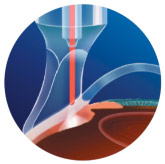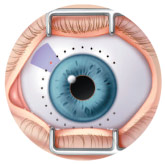The G-Probe® Delivery Device performs Continuous-Wave Transscleral Cyclophotocoagulation (CWTSCPC) to lower IOP through selective ablation of the ciliary processes. This simple, yet effective repeatable procedure can be performed in the office, operating room, or in conjunction with other procedures, like cataract surgery.
Continuous-Wave Transscleral Cyclophotocoagulation (CW-TSCPC) Using the Cyclo G6®, G-Probe®* and G-Probe Illuminate®*
Treatment Parameters & Techniques Based on Guidance from Dr. Gaasterland, et al.1, 2
 When using the G-Probe and G-Probe Illuminate devices with the Cyclo G6 laser:
When using the G-Probe and G-Probe Illuminate devices with the Cyclo G6 laser:

- Keep the probe tip and the eye surface moist throughout the procedure.
- Hold the G-Probe parallel to the visual axis with the shorter edge of the footplate firmly between the anterior border and the middle of the limbus.
- Do not treat over sites of previous trabeculectomies. Avoid areas of heavy perilimbal pigmentation.
- Spaced one-half the width of the G-Probe footplate by aligning the side of the G-Probe over the indented center of the adjacent application.
- Treat 270o (three quadrants) with 18-21 applications per treatment session, usually omitting the temporal quadrant.
Classic Technique1
| Laser Power | 2000 mW |
| Duration | 2000 ms |
| Laser Applications: | 18-21 Spots |
If you hear a “pop”, adjust laser power down 250 mW per application until you do not hear a “pop.” Then continue the applications at that power or until you hear another “pop.”
Slow-Burn Technique2
Dark Pigmentation
Dark Skin Pigmentation/Dark Colored Irises
| Laser Power | 1250 mW |
| Duration | 4000 ms |
| Laser Applications: | 18-21 Spots |
Light Pigmentation
Light Skin Pigmentation/Light Colored Irises
| Laser Power | 1500 mW |
| Duration | 3500 ms |
| Laser Applications: | 18-21 Spots |
Usually no, or few ‘pops’ will be heard.
Retreatment
Begin retreatment 45° from the initial treatment. The second 270° treatment will cover a half of the untreated quadrant, plus two and a half quadrants from the earlier treatment.
- Kosoko O, Gaasterland DE, Pollack IP, Enger CL: Long-Term Outcome of Initial Ciliary Ablation with Contact Diode Laser Transscleral Cyclophotocoagulation for Severe Glaucoma. The Diode Laser Ciliary Ablation Study Group. Ophthalmology 1996;103(8):1294-302.
- Gaasterland DE: Diode Laser Cyclophotocoagulation. Technique and Results. Glaucoma Today 2009;(March):35-38.
COMPATIBLE PRODUCTS
The G-Probe device is powered by the Cyclo G6 Laser. The Cyclo G6 Laser is an 810 nm infrared laser. It was launched in 2015, it is available in more than 60 countries, and it is used in 38 of the 39 best hospitals in the United States.* The Cyclo G6 Laser can be use in MicroPulse mode with the MicroPulse P3 Device and in continuous wave mode with the G-Probe Device and the G-Probe Illuminate Device.
*As ranked by U.S. News and World Report
FREQUENTLY ASKED QUESTIONS
1. What is the treatment technique for the G-Probe® Glaucoma Device?

For additional detailed instructions please refer to the IRIDEX G-Probe Instrumentation Instructions for Use.
2. What is the shelf life?
Three years
3. Is the G-Probe Device a single-use devices?
Yes, the G-Probe device has been validated for single use only.
4. What is the CPT code?
The CPT code for cyclophotocoagulation is 66710
5. What are the reimbursement rates for 66710?
National reimbursement for CPT code 66710 in the United States is as follows: $453 for physician payment in physician office, $400 for physician payment in ASC, $836 for facility payment in ASC, $400 for physician payment in hospital outpatient department, and $1,934 for facility payment in hospital outpatient department. Please consult your local Medicare and non-Medicare carriers for local rates and for coverage and payment policies
ORDERING
To order the G-Probe Device, speak with your local sales representative, distributor, email us at customerservice@iridex.com, or call us at +1.650.962.8100
- The part number is 15980
- Six probes are included in a box
- The G-Probe Device is a single-use device